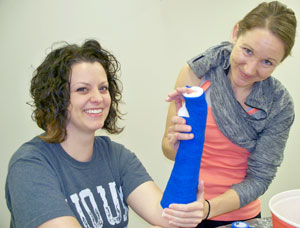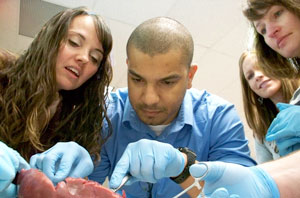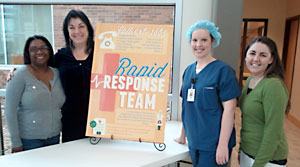Feb 26, 2015
Education at a Distance: Virtual Classrooms Bring Healthcare Classes to Rural Areas
by Kate Menzies

Rural communities are facing shortages of a major resource: healthcare professionals. A 2014 analysis from HRSA's National Center for Health Workforce Analysis (no longer available online) put this in perspective—of the 32 health occupations studied, over 80 percent had fewer providers per capita in rural areas than in urban. Challenges such as economic and educational disparities, coupled with rural isolation, present hurdles in the recruitment and retention of a skilled workforce in these areas.
Institutions across the country are seeking to address these issues by designing ways in which students can learn without having to leave their communities. These initiatives help rural communities "grow their own" healthcare professionals and allow rural workers to advance their careers. New advances in technology and information sharing have led some universities to move from the traditional classroom structure toward distance education courses and hybrid (distance/on-site) programs that allow professionals to keep working in their communities with minimal disruptions for coursework. This helps students take their newly acquired knowledge and skills back to the hospitals and clinics where they currently work.
Rural students often face challenges that inhibit them from attending traditional classes, according to Sue Skillman, Deputy Director of the WWAMI Center for Health Workforce Studies (WWAMI). Jobs, families and location can stop some students from pursuing degrees, Skillman said, but distance education courses give students an alternative to conventional classroom instruction.
But with any change comes criticism. Some opponents don't think distance education programs offer the same quality as traditional classroom learning. Skillman, however, sees great promise in this new form of learning. She said that adding clinical training requirements and laboratory experiences are ways that institutions can blend hands-on components with online learning to create a better education environment for students.
Some of the following institutions are doing just that.
Alaska OT Students Attend Nebraska School Via Video Conferencing
Although vastly different, universities in Alaska and Nebraska share something in common—a desire to deliver healthcare to rural regions with limited access.
Creighton University in Omaha, Neb., and the University of Alaska-Anchorage (UAA) have teamed up to create a unique hybrid learning model that gives occupational therapy (OT) students, regardless of location, a chance to earn their doctorate degrees.
These two unlikely partners came together in 2008 to address Alaska's shortage of therapists and its maldistribution of rehabilitation services. Many factors, such as the state's geography, remoteness, harsh climate and scarce training resources, had contributed to this problem; as a result, tribal villages and communities were suffering from inadequate care. From this partnership, the Creighton University Entry Level Distance Occupational Therapy Doctorate Program–Alaska (OTD Program) was born.
Utilizing a unique hybrid distance education program, residents of Alaska can earn a degree from the comfort of home. Creighton University develops the curriculum and content for the courses and distributes it through video conferencing technology to students. Clinical adjunct faculty in Alaska serve as mentors in the field and assist the Nebraska faculty by teaching the lab and experiential components of the program. The goals, objectives and core content are identical to that of Creighton University's on-campus pathway.
"Equipment, space and cost of starting, running and sustaining a program can be a costly endeavor," said Dr. Alfred Bracciano, coordinator of the OTD Program. "An independent program was not feasible."
An average of 10 students are admitted to the program each year. Bracciano said that the program numbers could fluctuate based on the needs of the community.
Creighton University, a private institution, and UAA, a state institution, each brings its own expertise to the partnership. Creighton has a long history of distance education programs in the health sciences. In fact, it had the first distance pharmacy program in the country, so it had the infrastructure in place to develop other distance education programs. UAA also had an infrastructure available due to its array of disciplines that had implemented distance education.
Students who wish to apply to the program are required to demonstrate that they are prepared to enter a hybrid program and show a particular interest for practicing OT in Alaska. Alaska residents are given first preference for this program, but non-residents can apply if they wish to relocate to the greater Anchorage area since all labs are facilitated at UAA.
One such student is Karianna Gallagher, who grew up in Alaska and wanted to practice her chosen field in the place that she loved. "I knew that I planned to stay and work as an OT in Alaska after graduation," Gallagher said. "Therefore, I thought it was important to plan my internships and network with the Alaskan OT community. The Creighton distance program allowed me to do that."
Tuition is set at a mutually decided rate between the institutions, including technology and lab fees. Students can apply for scholarships to ease their financial burden.
The sheer distance between the institutions and their distinct regional nuances pose some challenges, which is why communication is so vital for the well-being of the program.
"We must appreciate and respect the cultural differences as we navigate and negotiate a completely different system in Alaska," Bracciano said.
The program has proven itself successful by the number of graduates who have remained to practice in the state. Two graduates have even gone on to serve on the Alaska Occupational Therapy Association's Board of Directors.
(For more, see Students Earn OT Doctorates Through Nebraska-Alaska Program)
North Dakota Program Fills Healthcare Gaps
Physician Assistants (PAs) are helping fill the gap in healthcare coverage in rural communities, particularly for rural Medicare beneficiaries.
An innovative program in North Dakota addresses that need, making healthcare in rural areas of the state a priority. The University of North Dakota Department of Physician Assistant Studies Program (UND PA Program) is a hybrid distance-on-site program that aims to increase the number of PAs in the state. Preference for admission is given to students applying from rural, North Dakota areas; however, students from other locations are still encouraged to apply.
There are currently 306 licensed PAs in North Dakota. The UND PA Program (the only PA program in the state) has graduated approximately 50 percent of them.

This 90-credit program practices "sequential growth" where students learn concepts and skills in a series of alternating online courses, didactic periods on campus, and clinical experiences, in order to develop and apply primary care knowledge and skills on an individualized basis.
"This format works well for our students as it promotes sequential application of concepts shortly after didactic instruction, which promotes retention of content," said Dr. Jeanie McHugo, chair of the UND PA Program.
During their clinicals, students pair up with licensed physicians and/or PAs, who serve as clinical preceptors, in medical facilities.
This model allows professionals in rural areas to teach students firsthand how they practice and run their clinics in hopes that it will make students want to return there.
"It is a 'grow your own' mentality," McHugo said.
This approach has worked well, as 82 percent of graduates reside in the same city or town where they trained. This means that nearly 46 percent of graduates practice in rural areas.
A total of 1,721 graduates have completed the UND PA program. This is good news, as the Bureau of Labor Statistics projects that national employment for PAs is expected to increase 38 percent through the year 2022.
The UND program is funded through appropriated state dollars and a Health Resources and Services Administration (HRSA) grant for curriculum development, which focuses specifically on rural healthcare needs. Students are able to receive financial assistance through two internal scholarships and a scholarship offered through the North Dakota Academy of Physician Assistants. McHugo said some local communities also have donated money in the past to provide students with the funds to complete the program, provided they return to work at that particular healthcare facility.
(For more, see North Dakota Student Earning PA Degree Through Distance Program)
Virtual Practicum Helps Licensed Nurses Earn BSNs
The University of Missouri-Kansas City has created a RN-BSN Rural Nursing Initiative (RNI) to address the hardships that rural licensed nurses often face when they go back to school. The program is one of the only ones in the nation with a virtual practicum, allowing students to attend while in their hometowns.

The program's inception was made possible by a HRSA grant, which enabled the program to be entirely online. It has since grown to be a self-sustaining university-funded program. This set-up has helped rural distance students receive the same quality education as on-campus students, without an extra burden on them.
.JoAnn Klaassen, clinical associate professor at the UMKC School of Nursing and RNI director, said rural nurses who enter the program come in as a jack-of-all-trades, whereas urban nurses tend to be more specialized in a particular area. By allowing these groups to interact and team up, Klaassen said, students are able to play off of each other's skills to ultimately design programs that benefit rural areas during a yearlong practicum experience at the end of the program.
According to Klaassen, the program expands the view of what's possible within the nursing profession and allows students to form a new perspective on how they can use what they know to impact and engage with their communities.
"This initiative creates an authentic engagement with rural communities," Klaassen said. "Students feel like they are doing something that makes a difference."
Around 300 students currently are enrolled in the program and roughly 600 students have graduated from it.
Klaassen is excited about expanding the program globally by offering practice experiences that apply to different areas of the world. The program currently works with rural hospital nurses in Ethiopia and has recently started working with nurses in Liberia. "As long as we have connections, we can go anywhere in the world," she said.
In addition, the program is aiming to enhance interprofessional experiences through future collaborations with other medical fields like dentistry and physical therapy. The program already collaborates with social workers, pastors, educators, and the UMKC graphic design department, in helping to create more thorough practicum projects.
Students are among the program's biggest boosters. Virginia Slaughter has recruited many students for the program since she graduated from it. "This is a well-organized program with tremendous faculty and staff," she said. (For more, see Missouri RN Earns BS Nursing Degree Online)
A WWAMI study found that the top concerns of rural nursing professionals considering a distance education program include difficulty relocating, commuting, limited training opportunities in rural areas and the affordability of distance education. Klaassen said she believes technology can help alleviate these worries.
"We can do so much in the virtual world," Klaassen said.
Back to: Winter 2015 Issue
